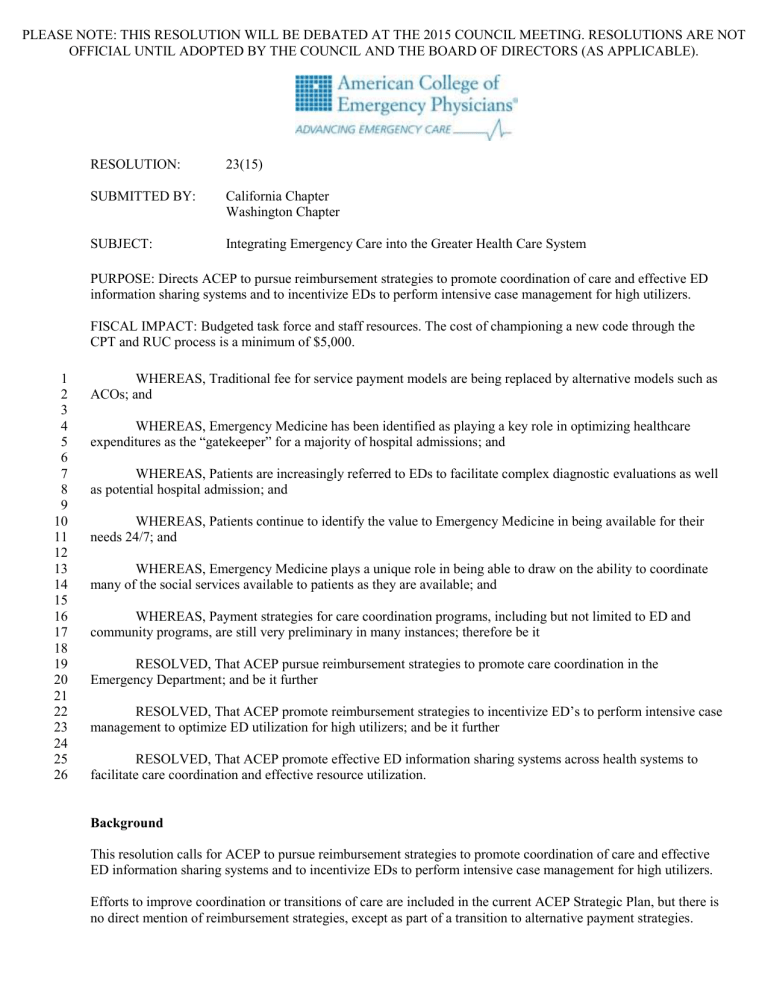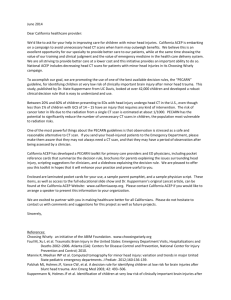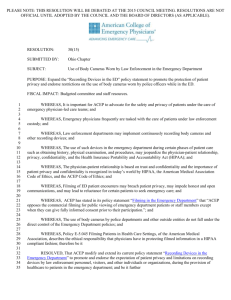Integrating Emergency Care into the Greater Health Care System

PLEASE NOTE: THIS RESOLUTION WILL BE DEBATED AT THE 2015 COUNCIL MEETING. RESOLUTIONS ARE NOT
OFFICIAL UNTIL ADOPTED BY THE COUNCIL AND THE BOARD OF DIRECTORS (AS APPLICABLE).
4
5
6
7
20
21
22
23
16
17
18
19
12
13
14
15
8
9
10
11
24
25
26
1
2
3
23(15) RESOLUTION:
SUBMITTED BY: California Chapter
Washington Chapter
SUBJECT: Integrating Emergency Care into the Greater Health Care System
PURPOSE: Directs ACEP to pursue reimbursement strategies to promote coordination of care and effective ED information sharing systems and to incentivize EDs to perform intensive case management for high utilizers.
FISCAL IMPACT: Budgeted task force and staff resources. The cost of championing a new code through the
CPT and RUC process is a minimum of $5,000.
WHEREAS, Traditional fee for service payment models are being replaced by alternative models such as
ACOs; and
WHEREAS, Emergency Medicine has been identified as playing a key role in optimizing healthcare expenditures as the “gatekeeper” for a majority of hospital admissions; and
WHEREAS, Patients are increasingly referred to EDs to facilitate complex diagnostic evaluations as well as potential hospital admission; and
WHEREAS, Patients continue to identify the value to Emergency Medicine in being available for their needs 24/7; and
WHEREAS, Emergency Medicine plays a unique role in being able to draw on the ability to coordinate many of the social services available to patients as they are available; and
WHEREAS, Payment strategies for care coordination programs, including but not limited to ED and community programs, are still very preliminary in many instances; therefore be it
RESOLVED, That ACEP pursue reimbursement strategies to promote care coordination in the
Emergency Department; and be it further
RESOLVED, That ACEP promote reimbursement strategies to incentivize ED’s to perform intensive case management to optimize ED utilization for high utilizers; and be it further
RESOLVED, That ACEP promote effective ED information sharing systems across health systems to facilitate care coordination and effective resource utilization.
Background
This resolution calls for ACEP to pursue reimbursement strategies to promote coordination of care and effective
ED information sharing systems and to incentivize EDs to perform intensive case management for high utilizers.
Efforts to improve coordination or transitions of care are included in the current ACEP Strategic Plan, but there is no direct mention of reimbursement strategies, except as part of a transition to alternative payment strategies.
Resolution 23(15) Integration Emergency Care into the Greater Health Care System
Page 2
ACEP initiated attempts during the AMA Current Procedural Terminology (CPT) Editorial Panel work on the original coordination and transition of care codes to have emergency medicine specifically referenced; however, that was not successful. The majority view was that these codes were only intended to be reported by the primary care physician coordinating the “medical home” for a given patient. Efforts to attempt an emergency department specific code would not likely be successful and would cost an estimated minimum of $5,000 to take through the
CPT and RBRVS Update Committee (RUC) process. Even if such an effort passed the CPT and RUC process,
CMS, and any private payer, would have to adopt the RUC’s recommendation. So far, CMS has indicated it considers coordination of care to be the role of the primary care physician and only one provider may report the code describing these services in a given month.
Some progress has been made through RUC member participation in AMA-sponsored listening sessions to have emergency medicine’s role in coordinating care in stroke and behavioral health episodes of care recognized. An
ACEP member, Jennifer Wiler, MD, FACEP, has been approved as the AMA nominee to the CMS Physician
Focused Payment Model Technical Advisory Committee (P-TAC) and is co-chair of the joint CPT and RUC
Emerging Issues Workgroup addressing non-face-to-face issues such as coordination of care and dealing with
RUC related questions on advanced payment models as they arise. ACEP has also formed an Alternative Payment
Models Task Force, which will consider issues of this nature.
ACEP Strategic Plan Reference
Goal 1 – Reform and Improve the Delivery System for Emergency Care
Objective A – Develop and promote delivery models that provide effective and efficient emergency medical care in difference environments. Tactics include:
Work with community groups and other organizations to promote opportunities for improvement and standardization for transitions of care reporting/communication.
Work with appropriate entities to promote the value of emergency medicine to the health care delivery system, including coordination of care and case management.
Collaborate with the Society of Hospital Medicine to improve transitions of care from the ED to the inpatient units.
Promote legislative initiatives and best practices for access to board-certified emergency physicians, via real-time, interactive telecommunications systems from rural and remote areas.
Monitor state developments related to Medicaid expansion and health insurance exchanges to help chapters identify and address emerging issues impacting emergency care.
Promote emergency medicine as an essential part of the health care system and use communication tools to help position emergency physicians to participate in new payment models.
Develop work value recommendations on the ED-relevant identified codes that have not been through the
RUC survey process to ensure values are maintained or increased. Begin preparations for the 2017 Five-
Year-Review.
Identify and monitor evolving payment methodologies and investigate strategies for emergency medicine to prosper under those most likely to prevail.
Fiscal Impact
Budgeted task force (Alternative Payment Models) and staff resources. The cost of championing a new code through the CPT and RUC process is a minimum of $5,000.
Prior Council Action
Resolution 36(13) Development of a Rapid Integration of Care Toolkit adopted. Directed that ACEP develop a rapid integration of care toolkit to focus on transitions of care and car coordination, provide best practices based upon hospital type and location, tools/resources for the design and implementation of rapid integration of care programs, and measures to report success of efforts.
Amended Resolution 22(11) Emergency Medicine and Transitions of Care adopted. Directed ACEP to define the role of emergency medicine in transitions of care for emergency medicine patients; to participate in all significant
Resolution 23(15) Integration Emergency Care into the Greater Health Care System
Page 2 forums of discussion with regulatory entities, Department of Health and Human Services, Centers for Medicare &
Medicaid Services, The Joint Commission, National Quality Forum, related to performance parameters and proposed standards for emergency medicine transitions of care; to monitor and have input into any reimbursement issues tied to transitions of care, including performance incentives and accountable care organization collaboration; and to identify resources and educational materials to improve transitions of care for emergency patients.
Substitute Resolution 34(07) Patient Support Services Addressing the Gaps adopted. Stated that the College supports that hospitals develop resources to improve emergency department patients’ access to outpatient community health and support services.
Prior Board Action
June 2015, approved the revised policy statement, “
Definition of Emergency Medicine
;” revised and approved
April 2008; revised and approved April 2001; reaffirmed October 1998; originally approved March 1986.
Resolution 36(13) Development of a Rapid Integration of Care Toolkit adopted.
October 2012, accepted the report of the Transitions of Care Task Force.
October 2012, accepted the report of the Cost Effective Care Task Force.
Resolution 22(11) Emergency Medicine and Transitions of Care adopted.
Resolution 34(07) Patient Support Services Addressing the Gaps adopted.
Background Information Prepared by: David McKenzie, CAE
Reimbursement Director
Reviewed By: Kevin Klauer, DO, EJD, FACEP, Speaker
James Cusick, MD, FACEP, Vice Speaker
Dean Wilkerson, JD, MBA, CAE, Council Secretary and Executive Director







